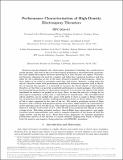Performance Characterization of High-Density Electrospray Thrusters
Author(s)
Corrado, Matthew N.; Wangari, Charity; Finch, Michael R.; Parameswaran, Lalitha; Cook, Matthew; Holihan, Eric C.; Mathews, Richard; Kedzierski, Jakub; Racz, Livia M.; Smith, Melissa A.; Lozano, Paulo C.; ... Show more Show less
DownloadIEPC-2024-811_Corrado.pdf (5.138Mb)
Open Access Policy
Open Access Policy
Creative Commons Attribution-Noncommercial-Share Alike
Terms of use
Metadata
Show full item recordAbstract
Research and development into electrospray propulsion technology has accelerated in recent decades. The state of the art in electrospray propulsion is microfabricated, passivelyfed, ionic liquid electrospray thrusters operating in or near the pure ion regime. Passivelyfed thrusters eliminate the need for complex and bulky flow regulation hardware and thus allow for the realization of one of the most attractive benefits of electrosprays, which is their ability to be scaled to extremely small sizes and masses. However, scaling down the
size of a thruster comes with performance penalties for extensive properties such as thrust. To circumvent this penalty, it is desirable to increase the thrust density of electrospray thrusters so that they can provide acceptable performance in small packages. One method for increasing thrust density in electrospray thrusters is to increase the density with which individual ion emitters are packed in an array. Here, we describe and test a design for an electrospray propulsion system that is well-suited for densification. The microfabricated
silicon emitters can be packed into arrays with pitch at least as small as 50 µm without loss of geometric feature quality, enabling potential increases in thrust density by a factor of 100 or more compared to the state of the art. We tested a prototype version of these thrusters with a 676-tip, 254-µm-pitch emitter array and a single emitter tip representative of the individual tips in the full array. The single tip produced current magnitudes of 100– 200 nA at voltages on the order of 1 kV, while the full array produced 150–200 µA at similar
voltage levels. Retarding potential analysis, time-of-flight mass spectrometry, and angleresolved current measurements were used to compute properties of the beams of both the single emitter and the full array. From these beam diagnositcs we estimate propulsive performance metrics of the thruster at current setpoints ranging from 50 µA to 150 µA in both the positive and negative firing polarities with EMI-BF4 propellant.
Description
The 38th International Electric Propulsion Conference, P. Baudis Convention Center, Toulouse, France, June 23-28, 2024
Date issued
2024-06Department
Massachusetts Institute of Technology. Department of Aeronautics and AstronauticsPublisher
Electric Rocket Propusion Society
Citation
Corrado, Matthew N., Wangari, Charity, Finch, Michael R., Parameswaran, Lalitha, Cook, Matthew et al. 2024. "Performance Characterization of High-Density Electrospray Thrusters."
Version: Author's final manuscript